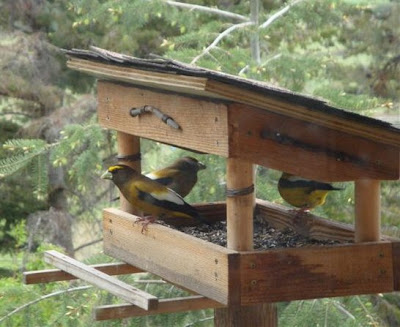 |
Bald Eagle rests outside our daughter's home in the Kentucky hills.
All photos here are by Kristin Farquharson. |
Our elder daughter and her family lived in Kentucky for five years. Just before they moved to Ontario late last summer, she took these photos from her deck. Their apartment building clung precariously to the edge of a very steep mountain, so steep that this eagle, at eyeball level with her deck, is near the top of a tree with its roots 100+ feet below.
I am a "flat-lander" born and bred and was both agoraphobic and claustrophobic in the steep hollers and narrow valleys. Granted, their deck was a marvelous bird-viewing platform - if one kept one's back to the wall and didn't go near the railing - and I loved seeing birds we don't have here - cardinals and titmice, tiny California Wrens, etc. One evening at dusk I looked straight up to see a swirling flock of Chimney Swifts silhouetted against the sky. Yup, you had to look straight up to see the sky.
Bald Eagles, fortunately, also visit the flatlands. In late November, I stood on our deck in Naicam (you can't fall off a ground level deck) and watched a lone eagle leisurely flapping north, following the Rail Trail. I wonder if he headed to Kentucky for the winter? Like cormorants, there are more Bald Eagles around now than when I was a child. They too suffered the consequences of DDT and one point were close to extinction in the USA.
Talking of eagles reminds me of my friend Fay in Delisle where we lived 6+ years before moving here almost five years ago. Fay loved to golf and most summer mornings at 6:30, we would head off in her golf cart, she with her clubs, me with my binoculars. Fay is a good golfer, a good athlete from a family of athletes. Her uncles, for example, were the Bentley brothers of hockey fame. With her sister as skip she was a Saskatchewan curling champion in 1965, '66 and '68, and runner up Canadian champion in '66. I, on the other hand, am possibly the world's worst golfer.
Nonetheless, it worked out well for us. When the golf cart was in motion, we visited, and when we stopped, she concentrated on her golf game, and I on the birds. Going out regularly on a regular route enabled me to know where to expect to see different birds and to note changes which I recorded in pocket memo book.
We entered the golf course at about the midway point through a gate off the back alley a block from our houses. The cart trail ran along the fence adjacent to the back alley for some distance allowing me to check song birds in the trees. This was also the highest spot looking out over the valley. Just beyond the golf course to the north was a hay field on the left, and gully on the right and beyond that trees, where a pair of Swainson's Hawks had nested. From my upper vantage point I was able to see the brooding hawk on the nest and eventually the two chicks growing until they fledged and left the nest. For a few days I saw them on the ground near the fence, their parents apparently still feeding them.
But one day it was another species that caught my eye. I had been watching a hawk on the fence when I noticed a coyote hunting in the field below. Through my binoculars, I could see it was after something, ears pricked forward, eyes to the ground, doing "puppy pounces." Suddenly it ducked aside as though it had been kicked. In fact, it had been dive bombed by the hawk and then bounded off to the safety of the underbrush in the gully.
The cryptic notes in the little coil-backed memo pad brings back such moments in great detail. Which brings me to the one notation on Aug. 13, 2003 that had nothing to do with birds, everything to do with golf.
* Fay - Eagle on 5
Such fun we had, Fay. Thanks. And now here's a few more Eagle-bird pix from Kristin.
 |
| Loose feathers from grooming? |
 |
| Swiveling his head like an owl. |






















